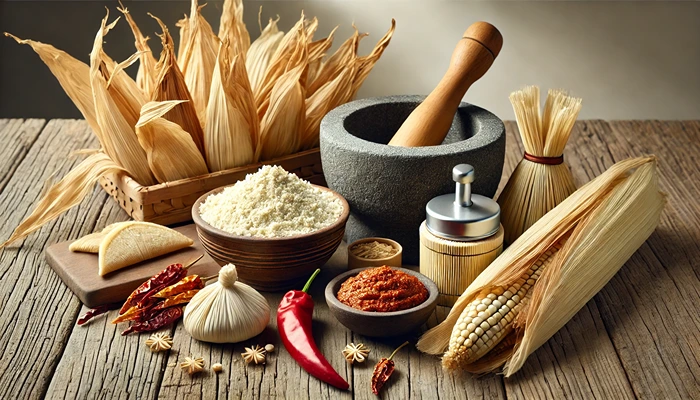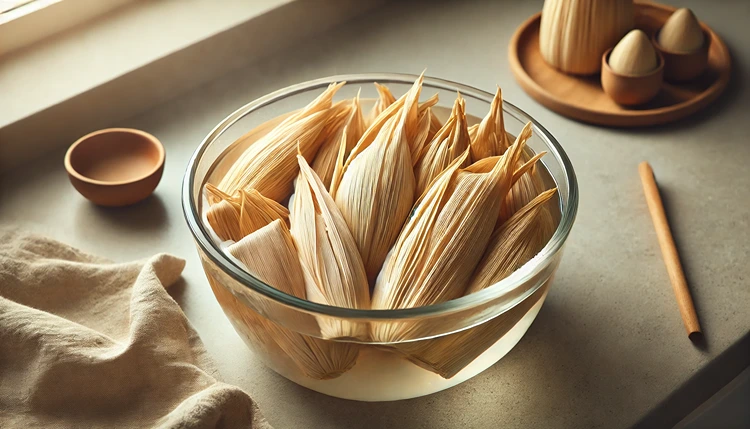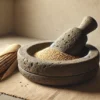The tamale, a culinary icon in Mexican cuisine, traces its roots back to the ancient Aztecs, who used corn and chili in ingenious ways to create flavors that still resonate today. Corn was sacred to the Aztecs, and tamales made from masa (corn dough) were central to many rituals and daily meals. Add chili peppers to the mix, and you have a dish that combines simplicity and depth in each bite. If you’re curious about recreating an authentic Aztec tamale recipe with corn and chili, you’re in for a flavorful journey.
Our focus keyphrase for this post is “Ancient Aztec Tamale Recipe with Corn and Chili.” By the time you finish reading, you’ll not only know how to make these tamales but will also appreciate the cultural significance behind each bite.
What Made Aztec Tamales Special?
The Aztecs, much like their predecessors, relied heavily on maize, or corn, as a staple. It wasn’t just food; it was life itself. Tamales were portable, versatile, and packed with nutrients, making them a perfect food for warriors and laborers. But what really made these tamales special was their ability to carry the rich, bold flavors of chili peppers, another staple in the Aztec diet.
Aztec tamales didn’t have the added fats or modern fillings we see today. They were simple, often just masa and a chili filling, wrapped in corn husks and steamed. The flavor came from the freshness of the ingredients, especially the smoky and spicy notes of dried chilies.
Corn: The Sacred Base of Tamales
Corn was the lifeblood of the Aztec diet. They cultivated different varieties, each with its unique properties. For tamales, the process of nixtamalization was crucial. This is where the corn kernels are soaked in an alkaline solution, which makes the dough pliable and increases its nutritional content. Masa harina, the modern version of what they used, is now easily available, but back then, making masa was a daily task.
Chili: The Flavor Powerhouse
Chili peppers were the heartbeat of Aztec cooking, and they had an incredible array of varieties to choose from. Whether fresh or dried, chili provided heat and depth of flavor to tamales. In ancient Aztec tamales, dried chilies like ancho or guajillo were often ground into a paste to be mixed with the masa or used as a filling.
How to Make Ancient Aztec Tamales with Corn and Chili
Now that you have some context, let’s dive into the recipe. Remember, we’re keeping this close to how it might have been in Aztec times, meaning simplicity is key. The focus is on masa, chilies, and basic spices. No cheese, no meats—just the core ingredients that fueled a civilization.
Ancient Aztec Tamale Recipe with Corn and Chili

Ingredients
- 2 cups masa harina
- 1 1/2 cups warm water
- 2 dried ancho chilies
- 2 dried guajillo chilies
- 1/2 teaspoon salt
- 12 dried corn husks (soaked in warm water)
Instructions
- Soak the corn husks in warm water for at least 30 minutes.
- Toast the dried chilies in a pan for a few minutes, then remove the seeds and stems.
- Grind the chilies into a paste using a mortar and pestle or food processor, adding a bit of water to form a smooth paste.
- Mix the masa harina, water, salt, and chili paste in a bowl until you get a smooth dough.
- Take a soaked corn husk and spread about 2 tablespoons of the masa mixture in the center.
- Fold the husk over the filling, then fold the bottom of the husk up.
- Steam the tamales for about 1 hour, until the masa is firm.
Notes
Feel free to experiment with different chilies for unique flavors. The masa can also be seasoned with herbs like epazote for an added layer of taste.
Why Were Corn and Chili So Important to the Aztecs?
Both corn and chili were essential not only to Aztec cuisine but also to their culture. Corn, or maize, was considered a gift from the gods, a symbol of life and sustenance. It was so sacred that they even had gods specifically tied to corn, like Centeotl, the maize god.
Chili, on the other hand, was more than just a way to spice up food. It played a vital role in the health of the Aztecs, acting as a preservative, a medicinal ingredient, and, of course, a flavor enhancer. Combining these two ingredients in tamales was more than just making food—it was about connecting with the earth and their ancestors.
Helpful Hint:
When grinding your chilies, try adding a splash of lime juice to bring out a tangy contrast to the spicy paste. This small trick can balance the flavors beautifully without altering the authentic Aztec feel of the tamale.
Aztec Ingredients and Their Significance
| Ingredient | Significance | Modern Use |
|---|---|---|
| Corn (Maize) | A sacred staple food for the Aztecs, representing life and sustenance. | Used in masa dough, tortillas, and various corn-based dishes. |
| Chili Peppers | Essential for flavoring and preservation, also considered medicinal. | Common in salsas, stews, tamales, and sauces for added heat and depth. |
| Amaranth | A highly nutritious grain-like seed important to Aztec rituals and diet. | Used in modern health foods like granola, cereals, and energy bars. |
| Squash | Provided nourishment and was commonly grown alongside maize. | Still a staple in Mexican cooking, often roasted or used in stews and salads. |
| Tomatoes | Introduced by the Aztecs, they were a key ingredient in their cuisine. | A base for sauces, salsas, and a variety of savory dishes. |
How Do You Steam Tamales Without a Steamer?
If you don’t have a traditional steamer, don’t worry! There are other ways to steam tamales that work just as well. You can use a deep pot with a small, heatproof bowl turned upside down at the bottom. Place a heatproof plate on top of the bowl and then layer your tamales on the plate. Add just enough water to reach the bowl, then cover the pot and steam as usual.
This method helps ensure your tamales steam properly without the need for special equipment. You’ll still get the same delicious result!
How to Serve and Enjoy Ancient Aztec Tamales
Once your tamales are steamed and ready, it’s time to enjoy them! Tamales are best served hot, straight out of the husk. In Aztec times, they may have been eaten plain or accompanied by a simple salsa made from ground tomatoes and chilies.
For a modern twist, you can serve these tamales with a side of beans or a spicy tomatillo sauce. Either way, they make a hearty meal that’s both filling and flavorful, with the essence of ancient Aztec cuisine.
Can You Freeze Tamales?
Yes, tamales freeze exceptionally well. After steaming, let them cool to room temperature, then wrap them in plastic wrap or aluminum foil before placing them in a freezer-safe bag. They can last up to three months frozen. When you’re ready to eat them, simply steam them again for about 15 minutes to warm them through.
Helpful Hint:
To make meal prep easier, consider making a large batch of tamales and freezing half. This way, you’ll always have a quick meal on hand that’s ready in minutes—perfect for busy days when you want something homemade and delicious.
Can You Use Different Types of Chilies in Tamales?
Absolutely! While the ancient Aztec tamales traditionally used dried chilies like ancho and guajillo, you can experiment with a variety of chili peppers to create different flavor profiles. Chilies vary in heat and flavor, so depending on your taste preferences, you can go mild or bold with your tamale fillings.
For example, pasilla chilies provide a rich, almost raisin-like sweetness, while chipotle peppers offer a smoky and spicy kick. If you’re a fan of heat, you might try using arbol chilies, which pack a serious punch. On the other hand, poblano peppers, often roasted and peeled, bring a mild and slightly earthy flavor that’s perfect if you want to tone down the spice.
The versatility of tamales means you can create endless combinations of chili fillings, each bringing its unique flavor to the masa. Feel free to experiment while keeping the basic Aztec structure intact.
Are Ancient Tamales Healthier Than Modern Versions?
In many ways, ancient Aztec tamales are simpler and potentially healthier than their modern counterparts. Contemporary tamales often include lard, meats, cheese, and other rich ingredients, which can make them heavier and higher in fat. Ancient tamales, by contrast, were plant-based, relying on corn and chili as the primary components.
Without the addition of processed fats, these tamales are lighter and focused on the natural flavors of the ingredients. Corn provides complex carbohydrates, while the chilies offer a range of vitamins like A and C, along with capsaicin, which has been known to promote metabolism and act as an anti-inflammatory.
So if you’re looking for a lighter, more natural alternative to the modern tamale, the ancient Aztec tamale with corn and chili is a great choice. It’s simple, wholesome, and full of flavor without the added fats or heavy ingredients.
Helpful Hint:
For a healthier twist on your tamales, consider adding vegetables like roasted squash, corn kernels, or sautéed mushrooms to the masa. These ingredients keep your tamales plant-based while adding extra nutrition and flavor.
How to Store Tamales for Freshness
Tamales can be stored in the refrigerator or freezer, depending on how long you plan to keep them. If you’re storing them in the fridge, make sure to wrap them tightly in plastic wrap or place them in an airtight container. They’ll stay fresh for about 3-5 days.
For longer storage, tamales can be frozen for up to three months. After steaming, let them cool completely before wrapping them individually in foil or plastic wrap. Place them in a freezer-safe bag and label them with the date. To reheat, simply steam them again for about 15-20 minutes or microwave them (covered with a damp paper towel) for about 2 minutes.
Can You Make Tamales Gluten-Free?
The good news is that traditional tamales are already gluten-free! Since they’re made with masa, which is naturally gluten-free, and wrapped in corn husks, there’s no need to worry about gluten-containing ingredients.
However, if you’re buying pre-made masa or masa harina, always double-check the packaging to ensure there’s no cross-contamination or added gluten-based ingredients. By sticking to simple, whole ingredients like corn and chili, you can enjoy tamales without any gluten concerns.
What Are Some Popular Side Dishes to Serve with Tamales?
Tamales are a meal on their own, but pairing them with the right side dishes can enhance the experience even more. In Aztec times, tamales were often eaten with simple sides like beans or squash, both of which provided added nutrition and texture to the meal.
In modern Mexican cuisine, tamales are frequently served with sides like refried beans, Mexican rice, or fresh salsa. A zesty guacamole or a crunchy jicama salad can also complement the rich and spicy flavors of the tamales.
- Refried Beans: A creamy, protein-packed side dish that pairs well with the corn-based tamales.
- Mexican Rice: Light, fluffy rice with hints of tomato and spices. Perfect for balancing out the spice from the chilies.
- Fresh Salsa: Whether it’s a spicy red salsa or a refreshing green tomatillo salsa, it adds freshness to the tamales.
- Guacamole: Creamy, rich, and refreshing, guacamole is a great contrast to the dense masa.
Can You Use Modern Cooking Tools for Ancient Recipes?
While it’s exciting to recreate ancient recipes like Aztec tamales, it’s okay to use modern tools for convenience. For instance, instead of grinding the masa by hand or using a mortar and pestle for the chilies, a food processor works just as well. A stand mixer can also save time when mixing the masa dough.
As for steaming the tamales, an electric steamer is perfectly fine, but as mentioned earlier, a deep pot with a makeshift steamer can work wonders if you don’t have specialized equipment.
The key is to maintain the essence of the recipe while taking advantage of modern conveniences that make the process quicker and easier. You don’t need to live like an Aztec to enjoy their tamales—you just need the right ingredients and a bit of creativity.
FAQs
Wrapping Up
Making tamales the ancient Aztec way, with corn and chili, is a chance to connect with the simplicity and depth of this traditional dish. These tamales are more than just a recipe; they are a window into a time when food was a true reflection of the earth and the people who cultivated it. The flavors of corn and chili, combined with the warmth of steamed masa, give you a taste of what the Aztecs might have enjoyed centuries ago.
Whether you’re making them for a special occasion or as a cozy meal at home, these tamales offer a flavorful, plant-based option that’s both satisfying and rich in history. The balance of chili heat and corn’s sweetness is a reminder of how humble ingredients can create incredible depth and satisfaction.








